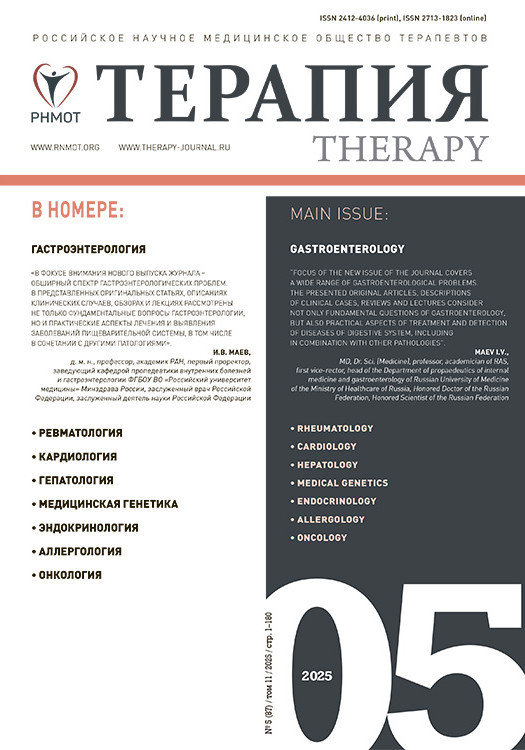Pharmacokinetics of indapamide in patients with arterial hypertension
Abstract. One of the reasons for the ineffectiveness of arterial hypertension (AH) therapy may be the peculiarities of antihypertensive drugs pharmacokinetics.Seleznev S.V., Mylnikov P.Yu., Shchulkin A.V., Yakushin S.S.
The aim: to evaluate indapamide pharmacokinetics in patients with controlled and uncontrolled AH.
Material and methods. Clinical, cross-sectional, controlled open cohort study was performed at the Regional Clinical Cardiology Dispensary (Ryazan). The analysis included 174 patients: 80 with controlled, 94 with uncontrolled AH. All participants regularly took a renin-angiotensin-aldosterone system blocker (lisinopril or valsartan), amlodipine, indapamide for a month. 106 patients received indapamide in the form of immediate release (IR) 2.5 mg, 68 – in the form of slow release (SR) 1.5 mg. In the morning on an empty stomach before and 2 hours after taking the drugs, venous blood samples were taken from all patients to assess the equilibrium concentration of indapamide (C0h) and its concentration 2 hours after administration (C2h) using high-performance liquid chromatography with tandem mass spectrometry.
Results. The patients of the compared groups were comparable in terms of AH stages and major comorbidities. The frequency of prescribing indapamide IR 2.5 mg and indapamide SR 1.5 mg in the controlled and uncontrolled AH groups did not differ statistically significantly. C0h and C2h of indapamide in the groups also did not have statistically significant differences. At the same time, both in patients with uncontrolled and controlled AH, there were revealed individuals whose indapamide concentration was below the level of quantitation (9.6 and 6.3%, respectively). During the correlation analysis, an inversely proportional correlation was established between the C0h of the studied drug and the level of diastolic blood pressure.
Conclusion. Changes in indapamide pharmacokinetics are not the main reason for the ineffectiveness of AH therapy. However, in 9.6% of patients with uncontrolled AH, indapamide was not detected in the blood serum and, as a result, did not have the necessary therapeutic effect.
Keywords
References
1. Thomas JR. A review of 10 years of experience with indapamide as an antihypertensive agent. Hypertension. 1985;7(6 Pt 2):152–56.
PMID: 4077233. https://doi.org/10.1161/01.hyp.7.6_pt_2.ii152
2. Duarte JD, Cooper-DeHoff RM. Mechanisms for blood pressure lowering and metabolic effects of thiazide and thiazide-like diuretics. Expert Rev Cardiovasc Ther. 2010;8(6):793–802.
PMID: 20528637. PMCID: PMC2904515. https://doi.org/10.1586/erc.10.27
3. Patel P, Preuss CV. Thiazide diuretics. 2025. In: StatPearls (Internet). Treasure Island (FL): StatPearls Publishing; January 2025. PMID: 30422513.
4. Chaffman M, Heel RC, Brogden RN, Speight TM, Avery GS. Indapamide. A review of its pharmacodynamic properties and therapeutic efficacy in hypertension. Drugs. 1984;28(3):189–235.
PMID: 6489195. https://doi.org/10.2165/00003495-198428030-00001
5. Caruso FS, Szabadi RR, Vukovich RA. Pharmacokinetics and clinical pharmacology of indapamide. Am Heart J. 1983;106(1 Pt 2):212–20.
PMID: 6869203. https://doi.org/10.1016/0002-8703(83)90119-9
6. Schiavi P, Jochemsen R, Guez D. Pharmacokinetics of sustained and immediate release formulations of indapamide after single and repeated oral administration in healthy volunteers. Fundam Clin Pharmacol. 2000;14(2):139–46.
PMID: 10796061. https://doi.org/10.1111/j.1472-8206.2000.tb00402.x
7. Кобалава Ж.Д., Конради А.О., Недогода С.В., Шляхто Е.В., Арутюнов Г.П., Баранова Е.И. с соавт. Артериальная гипертензия у взрослых. Клинические рекомендации 2024. Российский кардиологический журнал. 2024;29(9):230–329. (Kobalava ZhD, Konradi AO, Nedogoda SV, Shlyakhto EV, Arutyunov GP, Baranova EI et al. 2024 Clinical practice guidelines for hypertension in adults. Rossiyskiy kardiologicheskiy zhurnal = Russian Journal of Cardiology. 2024;29(9): 230–329 (In Russ.)).
EDN: GUEWLU. https://doi.org/10.15829/1560-4071-2024-6117
8. FDA Approved Drug Products: Lozol (indapamide). URL: https://www.accessdata.fda.gov/drugsatfda_docs/label/2009/018538s028lbl.pdf (date of access – 21.05.2025).
9. Bataillard A, Schiavi P, Sassard J. Pharmacological properties of indapamide. Rationale for use in hypertension. Clin Pharmacokinet. 1999;37 Suppl 1:7–12.
PMID: 10491728. https://doi.org/10.2165/00003088-199937001-00002
10. Lamirault G, Artifoni M, Daniel M et al. Nantes University Hospital Working Group on hypertension. Resistant hypertension: Novel insights. Curr Hypertens Rev. 2020;16(1):61–72.
PMID: 31622203. https://doi.org/10.2174/1573402115666191011111402
11. Клинические рекомендации. Артериальная гипертензия у взрослых. Общероссийская общественная организация «Российское кардиологическое общество». Рубрикатор клинических рекомендаций Минздрава России. 2020. ID: 62_2. Доступ: https://cr.minzdrav.gov.ru/preview-cr/62_2 (дата обращения – 21.05.2025). (Clinical guidelines. Arterial hypertension in adults. Russian Society of Cardiology. Rubricator of clinical guidelines of the Ministry of Healthcare of Russia. 2020. ID: 62_2. URL: https://cr.minzdrav.gov.ru/preview-cr/62_2 (date of access – 21.05.2025) (In Russ.)).
12. Seleznev S, Shchulkin A, Mylnikov P, Yakusheva E, Nikulina N. Therapeutic drug monitoring in arterial hypertension. J Pers Med. 2023;13(5):815.
https://doi.org/10.3390/jpm13050815
13. Urien S, Riant P, Renouard A, Coulomb B, Rocher I, Tillement JP. Binding of indapamide to serum proteins and erythrocytes. Biochem Pharmacol. 1988;37(15):2963–66.
PMID: 3395370. https://doi.org/10.1016/0006-2952(88)90282-1
14. Robinson DM, Wellington K. Indapamide sustained release: A review of its use in the treatment of hypertension. Drugs. 2006;66(2):257–71.
PMID: 16451099. https://doi.org/10.2165/00003495-200666020-00011
15. Weidmann P. Metabolic profile of indapamide sustained-release in patients with hypertension: Data from three randomised double-blind studies. Drug Saf. 2001;24(15):1155–65.
PMID: 11772148. https://doi.org/10.2165/00002018-200124150-00006
About the Authors
Sergey V. Seleznev, MD, PhD (Medicine), associate professor, associate professor of the Department of hospital therapy with the course of medical and social expertise, Academician I.P. Pavlov Ryazan State Medical University of the Ministry of Healthcare of Russia. Address: 390026, Ryazan, 96 Stroykova St.E-mail: sv.seleznev@gmail.com
ORCID: https://orcid.org/0000-0002-4069-8082. Scopus ID: 54981727100. eLibrary SPIN: 8322-0400
Pavel Yu. Mylnikov, MD, PhD (Biology), associate professor of the Department of pharmacology, Academician I.P. Pavlov Ryazan State Medical University of the Ministry of Healthcare of Russia. Address: 390026, Ryazan, 34, bld. 2 Shevchenko St.
E-mail: dukeviperlr@gmail.com
ORCID: https://orcid.org/0000-0001-7829-2494. Scopus ID: 57197797490. eLibrary SPIN: 8503-3082
Alexey V. Shchulkin, MD, Dr. Sci. (Medicine), associate professor, professor of the Department of pharmacology, Academician I.P. Pavlov Ryazan State Medical University of the Ministry of Healthcare of Russia. Address: 390026, Ryazan, 34, bld. 2 Shevchenko St.
E-mail: alekseyshulkin@rambler.ru
ORCID: https://orcid.org/0000-0003-1688-0017. Scopus ID: 55700396200. eLibrary SPIN: 2754-1702
Sergey S. Yakushin, MD, Dr. Sci. (Medicine), professor, head of the Department of hospital therapy with a course in medical and social expertise, Academician I.P. Pavlov Ryazan State Medical University of the Ministry of Healthcare of Russia. Address: 390026, Ryazan, 96 Stroykova St.
E-mail: prof.yakushin@gmail.com
ORCID: https://orcid.org/0000-0002-1394-3791. Scopus ID: 36740123600. eLibrary SPIN: 7726-7198



